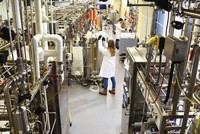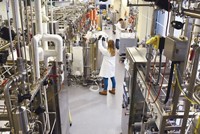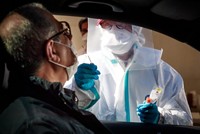Advertisement
Grab your lab coat. Let's get started
Welcome!
Welcome!
Create an account below to get 6 C&EN articles per month, receive newsletters and more - all free.
It seems this is your first time logging in online. Please enter the following information to continue.
As an ACS member you automatically get access to this site. All we need is few more details to create your reading experience.
Not you? Sign in with a different account.
Not you? Sign in with a different account.
ERROR 1
ERROR 1
ERROR 2
ERROR 2
ERROR 2
ERROR 2
ERROR 2
Password and Confirm password must match.
If you have an ACS member number, please enter it here so we can link this account to your membership. (optional)
ERROR 2
ACS values your privacy. By submitting your information, you are gaining access to C&EN and subscribing to our weekly newsletter. We use the information you provide to make your reading experience better, and we will never sell your data to third party members.
Diagnostics
Covid-19
China’s new place on the front lines of diagnosing and treating coronavirus disease
Industry watchers say the effort is unprecedented and would not have been possible during the last SARS outbreak
by Megha Satyanarayana with reporting by Cici Zhang
February 28, 2020

In 2003, in the middle of the severe acute respiratory syndrome (SARS) epidemic in China, Nisa Leung was a young entrepreneur there, trying to start a health care company.
As labs outside the country tried to develop diagnostics, and as repurposed antivirals and antibiotics proved weak or ineffective, Leung became acutely aware of one thing: China had little in the way of a homegrown drug and medical technology industry that could diagnose and treat this kind of disease on its own turf.
Fifteen years later, in the midst of an outbreak of a new, deadly coronavirus, Leung says this is a different China. The country has expanded beyond manufacturing generics and doing contract research to being able to develop novel diagnostics and engage in true drug discovery. Local biotech and pharmaceutical companies are working around the clock to develop and test therapies and vaccines. And the presence in China today of global drugmakers is easing international collaboration.
The response is not perfect, but Leung, now one of the lead investors at the venture capital firm Qiming Venture Partners, says that it is light-years ahead of what she saw in 2003.
Support nonprofit science journalism
C&EN has made this story and all of its coverage of the coronavirus epidemic freely available during the outbreak to keep the public informed. To support us:
Donate Join Subscribe
“I think we’ve gone a really long way from, you know, having nothing,” Leung says, recalling a major trade conference in 2003 that exhibited nothing but outdated technologies. “Back then, there weren’t many health care companies in China that could really help. Just seeing how China grew in the last 15 years, it’s really quite amazing.”
This more mature industry is now being put to the test: As of Feb. 27, a novel coronavirus known formally as SARS-CoV-2 has infected more than 82,500 people worldwide, about 96% of whom are in China. More than 2,800 people in China have died of the respiratory infection.
On the ground in China are several companies running diagnostic tests for SARS-CoV-2, including Adicon Clinical Laboratories, based in Hangzhou. At a recent forum on the novel coronavirus, CEO Victor Shi described the crushing workload at the firm’s lab in Wuhan, where the outbreak originated: thousands of samples coming in each day and workers laboring in 12-hour shifts in diapers and with no food or water to avoid having to get in and out of precious biohazard suits.
He also described the challenges that Adicon and others face when rolling out a new diagnostic in the middle of an outbreak. The tests, based on polymerase chain reaction (PCR), can’t be as rigorously validated before use as they would be under normal circumstances. This process normally takes a couple of years. Samples have impurities and are unstable. They haven’t been collected, stored, or transported properly. The people the samples are coming from range from asymptomatic to very sick. And scientists are still trying to figure out at what point during infection the viral load peaks, important for producing the best diagnostic results.
“Not only is the test less standardized, we also have not-well-documented patient records. It is difficult in this explosive outbreak, in this wartime, to conduct and validate these tests,” Shi said.
BGI, a genomics company based in Shenzhen, says it is trying to make 80,000 reverse transcriptase PCR diagnostic kits per day, for use in China and outside the country. The company says it has set up a laboratory in Wuhan, to “provide accurate scientific judgment for the detection of suspected cases and screening of high-risk groups.”
Two companies that Leung’s firm has invested in are helping with both molecular and imaging diagnostics. Chain Medical Labs, based in Hangzhou, is providing diagnostic services for the hospitals that have been created seemingly overnight in Hubei province, where Wuhan is located, to treat people with coronavirus infection. And Infervision is using artificial intelligence to help scan lung images.

With the growing number of coronavirus diagnoses comes many efforts to find small-molecule and biologic treatments for COVID-19, the disease caused by the virus. There is no “strongly” recommended treatment, although some people with the infection are being treated with mixed success with antiviral compounds called interferons and with AbbVie’s HIV antiviral Kaletra, a combination of lopinavir and ritonavir.
The search for a therapy highlights another major change in China since the 2002–2003 SARS epidemic, says Harri Jarvelainen, a life sciences consultant who has been based in China since 2012. Over the years, he says, China has developed the infrastructure to conduct global clinical trials. Of the thousands in progress, many are testing therapies for coronavirus, including existing antivirals, traditional Chinese medicines, and interferon.
“We have almost 100 trials in China, testing different drugs and treatments for coronavirus, and that never would have been possible in 2003,” he says.
One of the treatments most advanced in clinical trials is Gilead Sciences’ remdesivir, a nucleoside analog originally developed to treat Ebola. In collaboration with hospitals in Hubei province, the US biotech firm has been running clinical trials for several weeks, and results are expected in April. On Feb. 26, the company announced two Phase III trials of its own to start enrollment in March.
Several companies based in China are working on repurposing drugs. For example, Hisun Pharmaceutical has been cleared to test an influenza drug called favilavir to treat coronavirus.
A partnership between WuXi Biologics and Vir Biotechnology hopes to develop monoclonal neutralizing antibodies against the virus. Jarvelainen says the partners are looking to begin trials within four to five months. This speed is possible because of the R&D infrastructure that has sprung up within the country, but also because of a sense of urgency.
“It’s almost like a wartime, the effort. The measures the government and companies can take is really drastic,” he says.
In the meantime, several groups, both academic and in industry, are using machine learning to develop novel small molecules to fight coronavirus. One company, Hong Kong–based Insilico Medicine, has predicted six compounds that might work against the coronavirus protease.
Chinese firms are also active in researching vaccines for the coronavirus. The Chinese government has asked one of China’s leading vaccine developers, Cansino, to develop a preventative as quickly as possible, Leung says.
“They have a very comprehensive platform that can develop that,” she says, noting that China approved CanSino’s Ebola vaccine. This platform and other efforts to develop vaccines in-country were virtually nonexistent during SARS, she says.
In addition to efforts in diagnostics, drugs, and vaccines, China’s internal response to the coronavirus has improved, Leung says, thanks in part to new technology. In response to quarantines and curfews, WeDoctor, also based in Hangzhou, has recruited about 10,000 doctors to conduct telemedicine and online medical visits with people who think they might be sick.
It’s an all-out effort, Leung and Jarvelainen say, one that would not have been possible during the SARS outbreak in 2003. And despite frustration that some people have negatively labeled the coronavirus a Chinese disease, Jarvelainen says, people are coming together and making the best of a tough situation.
“There is some sort of pride element,” he says. “People feel that they are in this together.”





Join the conversation
Contact the reporter
Submit a Letter to the Editor for publication
Engage with us on Twitter